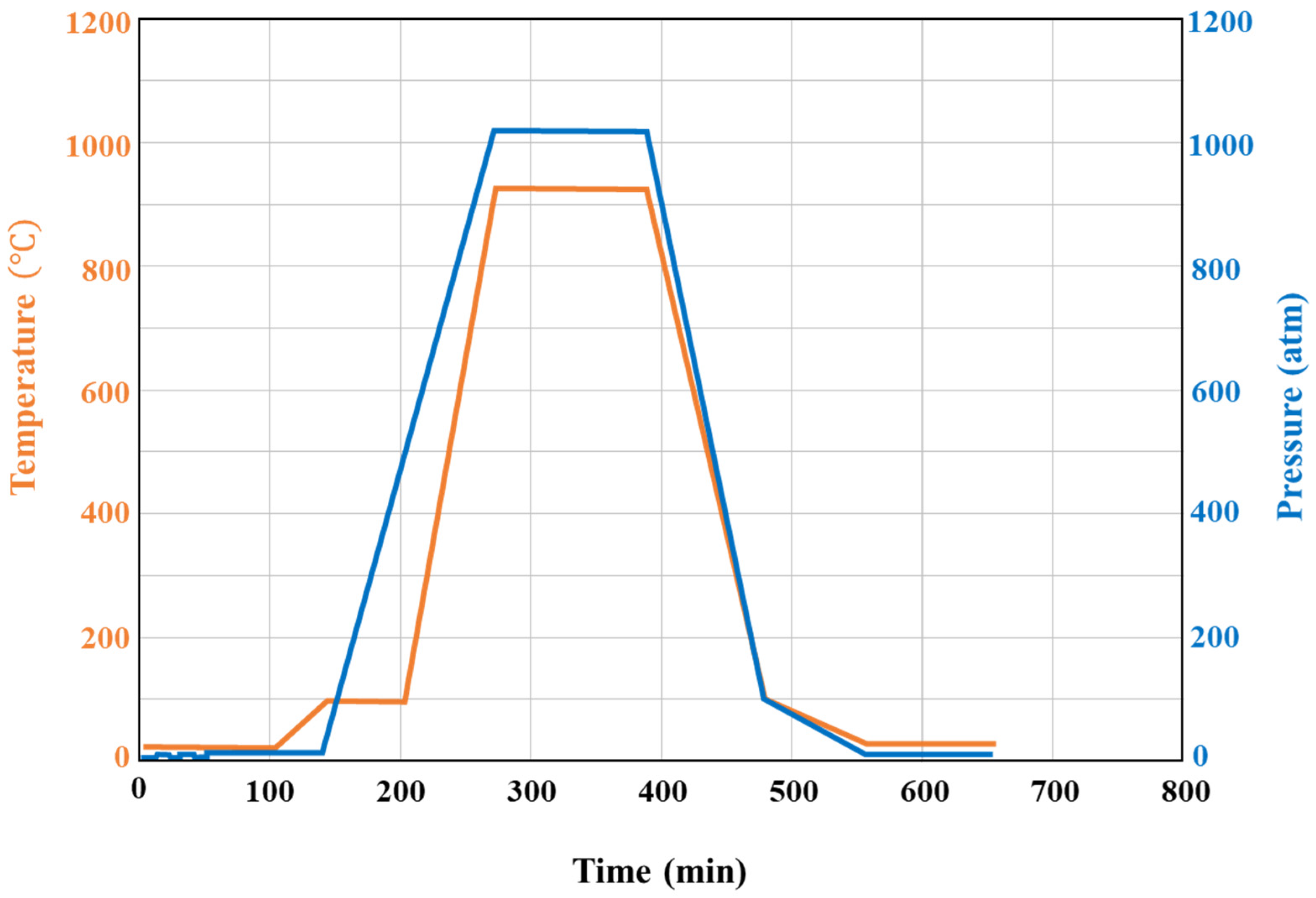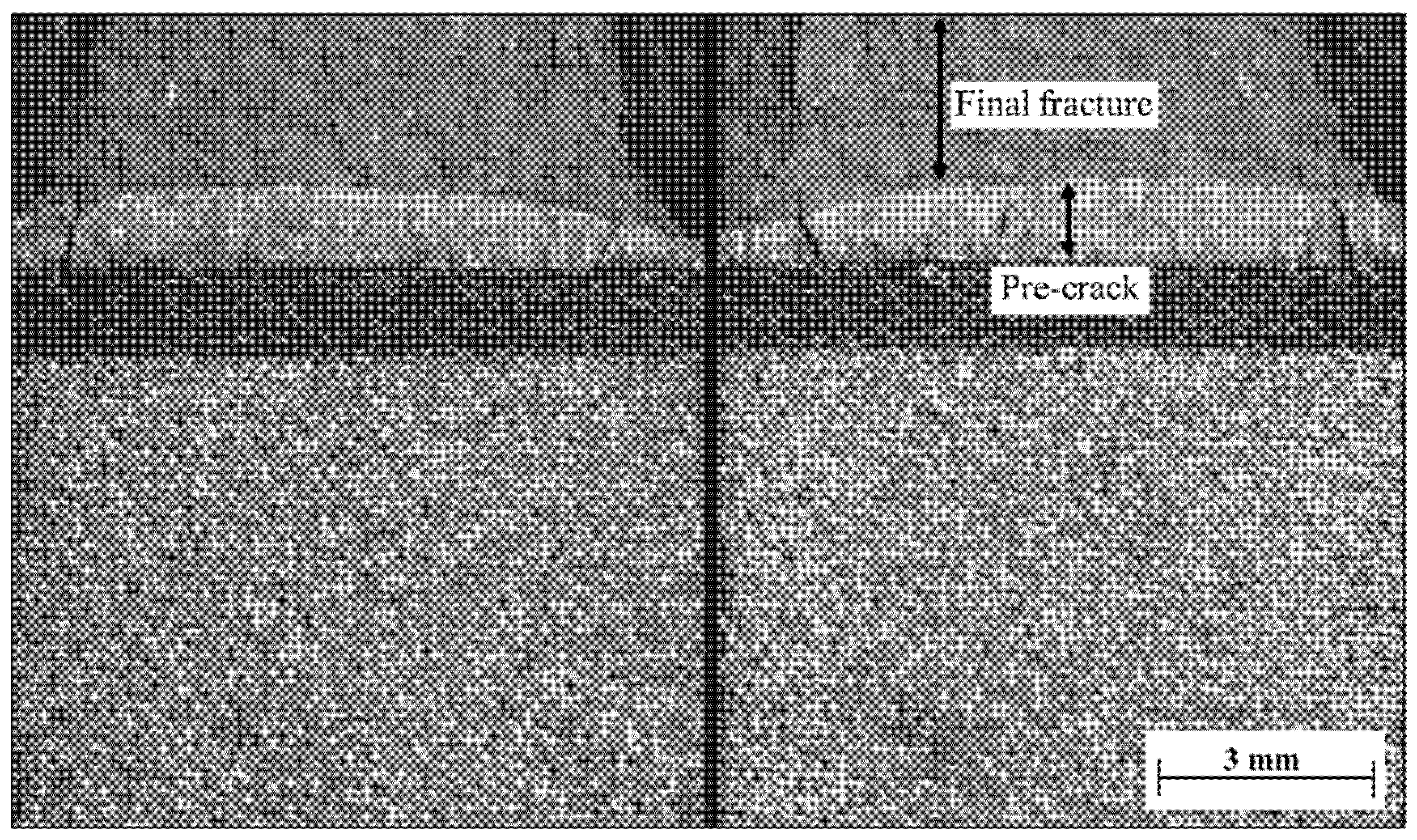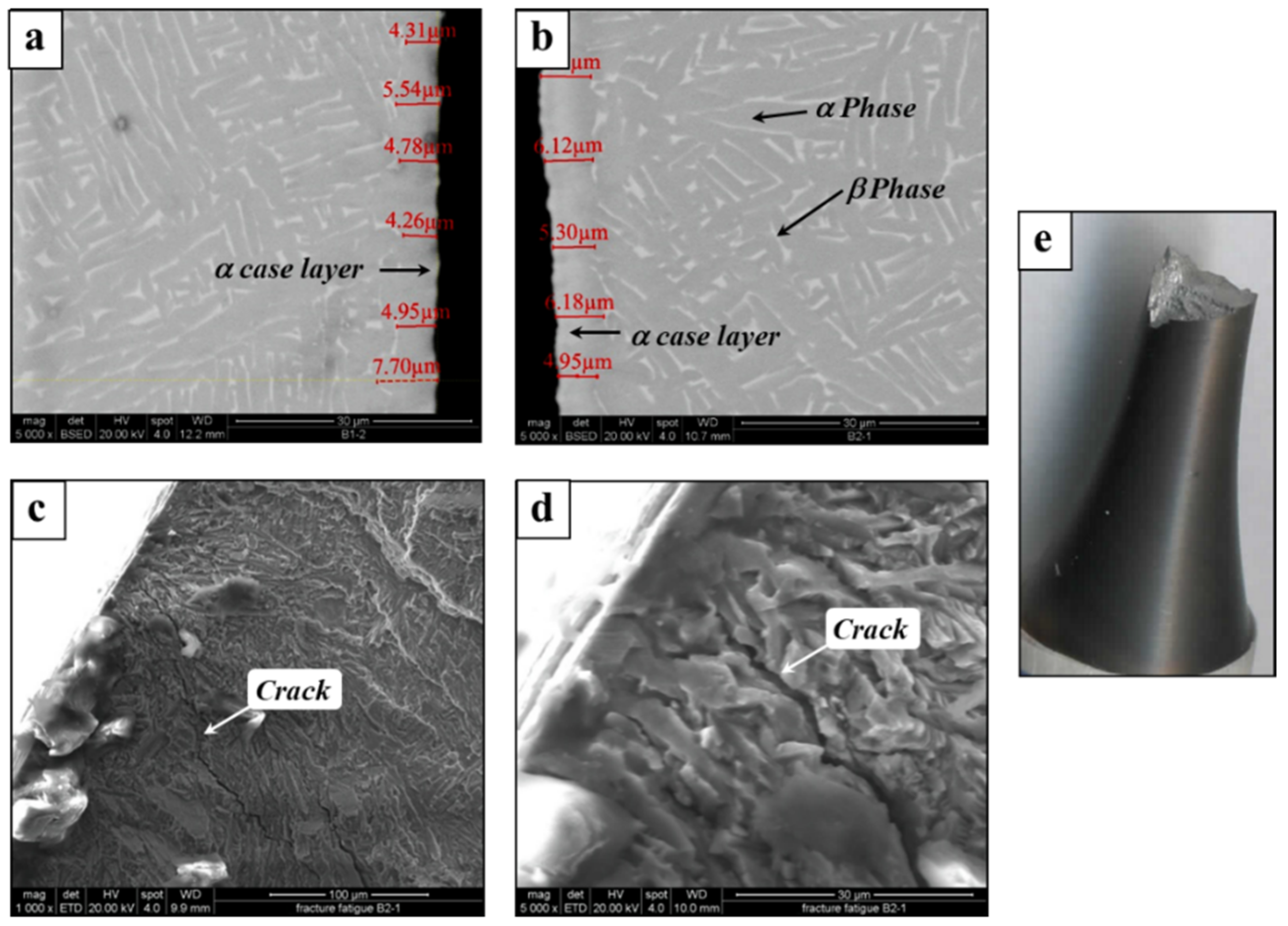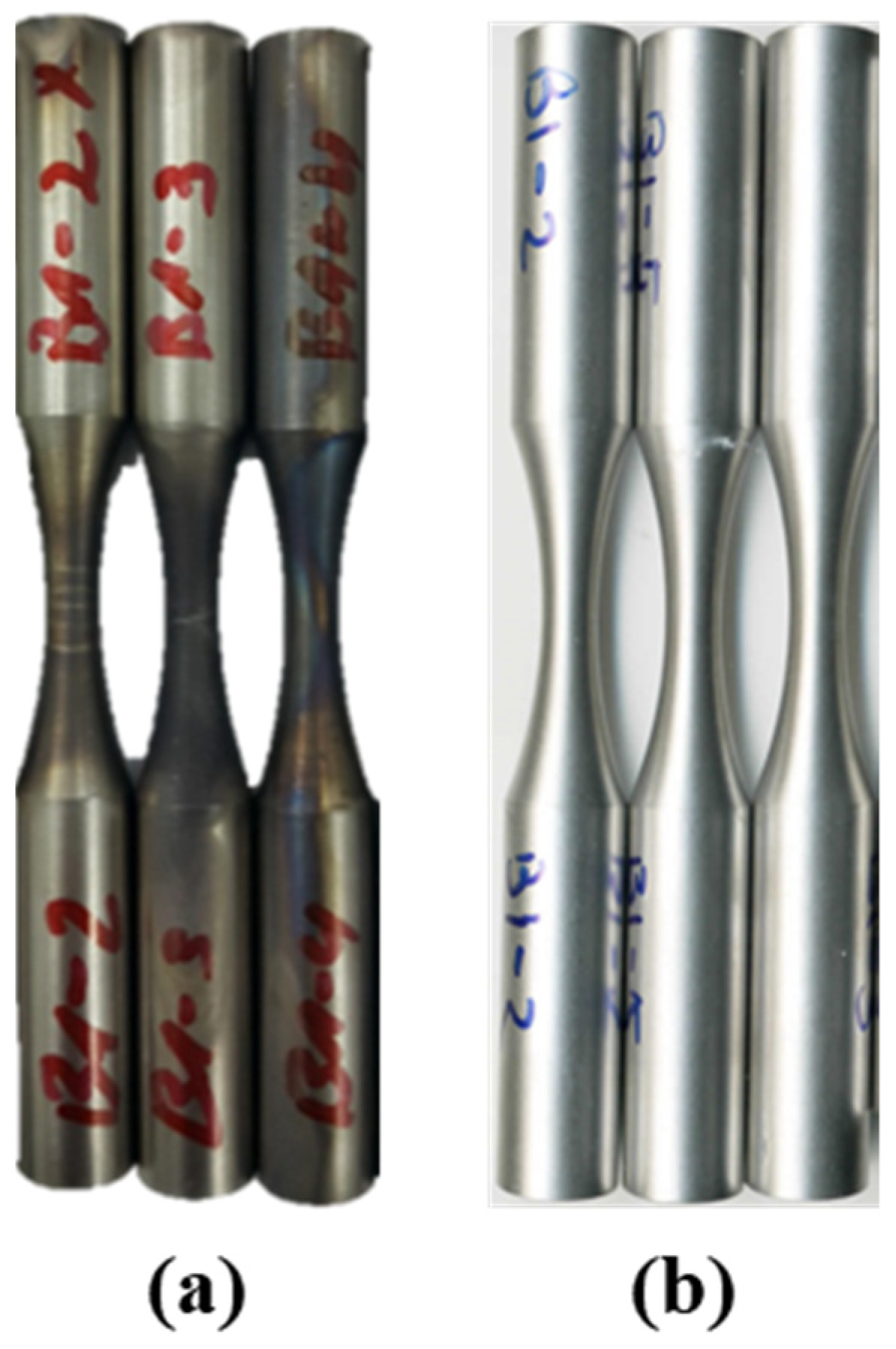Effect of HIP Defects on the Mechanical Properties of Additive Manufactured Ti6Al4V Alloy
Abstract
:1. Introduction
2. Materials and Methods
- As built (stress relief and machined);
- HIPed and machined—a common procedure according to the fatigue standard;
- Machined and HIPed—to resemble complex geometries that cannot machined after being built.
3. Results and Discussion
3.1. Tensile Tests: Tensile Properties Were Measured in the Build Direction
3.2. Fracture Toughness
3.3. Fatigue
4. Summary and Conclusions
- (1)
- The HIPed and machined operation represents the quality of the Ti-6Al-4V material built in the powder bed process.
- (2)
- The comparison between the as-built stress relief and HIPed specimens indicates an improvement in the material properties: elongation (75%), reduction in area (47%), fracture toughness (90%) and fatigue limits (24%), as well as a decrease in yield strength (21%) and tensile strength (19%).
5. Significant Results: Recommendations for High-Quality Parts
- (1)
- When designing parts for fatigue loading, special care should be taken with regard to the unmachined surfaces due to the dramatic decreases in the fatigue limits of the parts.
- (2)
- When the machining operation takes place during or after the building process and prior to the HIP process, special care should be taken with regard to the HIP procedure. Any contamination in the gas environment may cause failure in the fatigue life and limitations.
- (3)
- Failure in HIPed parts due to the alpha case layers can be removed by etching, which improves the fatigue limits in comparison to the as-built stress relief parts, but less than HIPed and the machined samples.
- (4)
- The applicable qualification standards for the examined mechanical properties correlate with conventional materials and represent the properties of AM materials; however, in many cases, they do not represent the geometry sensitivity of AM parts.
Author Contributions
Funding
Institutional Review Board Statement
Informed Consent Statement
Data Availability Statement
Acknowledgments
Conflicts of Interest
References
- Peters, M.; Kumpfert, J.; Ward, C.H.; Leyens, C. Titanium Alloys for Aerospace Applications. In Titanium and Titanium Alloys: Fundamentals and Applications; Leyens, C., Peters, M., Eds.; Wiley-VCH Verlag GmbH & Co. KGaA: Weinhem, Germany, 2003; Chapter 13; ISBN 9783527305346. [Google Scholar] [CrossRef]
- Gomez-Gallegos, A.; Mandal, P.; Gonzalez, D.; Zuelli, N.; Blackwell, P. Studies on Titanium Alloys for Aerospace Application. Defect Diffus. Forum 2018, 385, 419–423. [Google Scholar] [CrossRef] [Green Version]
- Henriques, V.A.R. Titanium production for aerospace applications. J. Aerosp. Technol. Manag. 2009, 1, 7–17. [Google Scholar] [CrossRef]
- Mirgal, N.; Ibrahim, M.M. Titanium: Metal of 21st Century. Int. J. Adv. Eng. Res. Sci. IJAERS 2016, 3, 2349–6495. Available online: www.ijaers.com (accessed on 6 June 2022).
- Khairallah, S.A.; Anderson, A.T.; Rubenchik, A.; King, W.E. Laser powder-bed fusion additive manufacturing: Physics of complex melt flow and formation mechanisms of pores, spatter, and denudation zones. Acta Mater. 2016, 108, 36–45. [Google Scholar] [CrossRef] [Green Version]
- Leon, A.; Katarivas Levy, G.; Ron, T.; Shirizly, A.; Aghion, E. The effect of strain rate on stress corrosion performance of Ti6Al4V alloy produced by additive manufacturing process. J. Mater. Res. Technol. 2020, 9, 4097–4105. [Google Scholar] [CrossRef]
- Negi, S.; Nambolan, A.A.; Kapil, S.; Joshi, P.S.; Raja, M.; Karunakaran, K.P.; Bhargava, P. Review on electron beam based additive manufacturing. Rapid Prototyp. J. 2020, 26, 485–498. [Google Scholar] [CrossRef]
- Gong, X.; Anderson, T.; Chou, K. Review on powder-based electron beam additive manufacturing technology. Manuf. Rev. 2014, 1, 2. [Google Scholar] [CrossRef]
- Leon, A.; Levy, G.K.; Ron, T.; Shirizly, A.; Aghion, E. The effect of hot isostatic pressure on the corrosion performance of Ti-6Al-4 V produced by an electron-beam melting additive manufacturing process. Addit. Manuf. 2020, 33, 101039. [Google Scholar] [CrossRef]
- Costa, L.; Vilar, R. Laser powder deposition. Rapid Prototyp. J. 2009, 15, 264–279. [Google Scholar] [CrossRef]
- Baghdadchi, A.; Hosseini, V.A.; Bermejo, M.A.V.; Axelsson, B.; Harati, E.; Högström, M.; Karlsson, L. Wire Laser Metal Deposition Additive Manufacturing of Duplex Stainless Steel Components—Development of a Systematic Methodology. Materials 2021, 14, 7170. [Google Scholar] [CrossRef]
- Ron, T.; Dolev, O.; Leon, A.; Shirizly, A.; Aghion, E. Effect of Phase Transformation on Stress Corrosion Behavior of Additively Manufactured Austenitic Stainless Steel Produced by Directed Energy Deposition. Materials 2020, 14, 55. [Google Scholar] [CrossRef] [PubMed]
- Ron, T.; Levy, G.K.; Dolev, O.; Leon, A.; Shirizly, A.; Aghion, E. Environmental behavior of low carbon steel produced by a wire arc additive manufacturing Process. Metals 2019, 9, 888. [Google Scholar] [CrossRef] [Green Version]
- Druzgalski, C.L.; Ashby, A.; Guss, G.; King, W.E.; Roehling, T.T.; Matthews, M.J. Process optimization of complex geometries using feed forward control for laser powder bed fusion additive manufacturing. Addit. Manuf. 2020, 34, 101169. [Google Scholar] [CrossRef]
- McNeil, J.L.; Sisco, K.; Frederick, C.; Massey, M.; Carver, K.; List, F.; Qiu, C.; Mader, M.; Sundarraj, S.; Babu, S.S. In-Situ Monitoring for Defect Identification in Nickel Alloy Complex Geometries Fabricated by L-PBF Additive Manufacturing. Metall. Mater. Trans. A 2020, 51, 6528–6545. [Google Scholar] [CrossRef]
- Ron, T.; Leon, A.; Popov, V.; Strokin, E.; Eliezer, D.; Shirizly, A.; Aghion, E. Synthesis of Refractory High-Entropy Alloy WTaMoNbV by Powder Bed Fusion Process Using Mixed Elemental Alloying Powder. Materials 2022, 15, 4043. [Google Scholar] [CrossRef] [PubMed]
- ASTM E8/E8M-09; Standard Test Methods for Tension Testing of Metallic Materials. ASTM International: West Conshohocken, PA, USA, 2012. [CrossRef]
- ASTM E399-17; Standard Test Method for Linear-Elastic Plane-Strain Fracture Toughness KIC of Metallic Materials. ASTM International: West Conshohocken, PA, USA, 2019. [CrossRef]
- ASTM E466-15; Standard Practice for Conducting Force Controlled Constant Amplitude Axial Fatigue Tests of Metallic Materials. ASTM International: West Conshohocken, PA, USA, 2021. [CrossRef]
- Monzón, M.D.; Ortega, Z.; Martínez, A.; Ortega, F. Standardization in additive manufacturing: Activities carried out by international organizations and projects. Int. J. Adv. Manuf. Technol. 2015, 76, 1111–1121. [Google Scholar] [CrossRef]
- ASTM ISO/ASTM52921-13; Standard Terminology for Additive Manufacturing-Coordinate Systems and Test Methodologies. ASTM International: West Conshohocken, PA, USA, 2019. [CrossRef]
- Beretta, S.; Romano, S. A comparison of fatigue strength sensitivity to defects for materials manufactured by AM or traditional processes. Int. J. Fatigue 2017, 94, 178–191. [Google Scholar] [CrossRef]
- Wycisk, E.; Solbach, A.; Siddique, S.; Herzog, D.; Walther, F.; Emmelmann, C. Effects of Defects in Laser Additive Manufactured Ti-6Al-4V on Fatigue Properties. Phys. Procedia 2014, 56, 371–378. [Google Scholar] [CrossRef] [Green Version]
- Ganor, Y.I.; Tiferet, E.; Vogel, S.C.; Brown, D.W.; Chonin, M.; Pesach, A.; Hajaj, A.; Garkun, A.; Samuha, S.; Shneck, R.Z.; et al. Tailoring Microstructure and Mechanical Properties of Additively-Manufactured Ti6Al4V Using Post Processing. Materials 2021, 14, 658. [Google Scholar] [CrossRef]
- Tiferet, E.; Ganor, M.; Zolotaryov, D.; Garkun, A.; Hadjadj, A.; Chonin, M.; Ganor, Y.; Noiman, D.; Halevy, I.; Tevet, O.; et al. Mapping the Tray of Electron Beam Melting of Ti-6Al-4V: Properties and Microstructure. Materials 2019, 12, 1470. [Google Scholar] [CrossRef] [Green Version]
- ASTM F2924-14; Standard Specification for Additive Manufacturing Titanium-6 Aluminum-4 Vanadium with Powder Bed Fusion. ASTM International: West Conshohocken, PA, USA, 2014.
- Quintus Technologies AB; Oak Ridge National Laboratory. Hot Isostatic Pressing: Improving quality and performance in AM parts Production. Metal Addit. Manuf. 2015, 1, 41–50. [Google Scholar]
- Leuders, S.; Tröster, T.; Riemer, A.; Richard, H.A.; Niendorf, T. On the mechanical performance of structures manufactured by selective laser melting: Damage initiation and propagation. In Proceedings of the Additive Manufacturing with Powder Metallurgy Conference, Orlando, FL, USA, 18–20 May 2014. [Google Scholar]
- Günther, J.; Krewerth, D.; Lippmann, T.; Leuders, S.; Tröster, T.; Weidner, A.; Biermann, H.; Niendorf, T. Fatigue life of additively manufactured Ti–6Al–4V in the very high cycle fatigue regime. Int. J. Fatigue 2017, 94, 236–245. [Google Scholar] [CrossRef]
- Sanaei, N.; Fatemi, A. Defects in additive manufactured metals and their effect on fatigue performance: A state-of-the-art review. Prog. Mater. Sci. 2021, 117, 100724. [Google Scholar] [CrossRef]
- Horiya, T.; Kishi, T. Fracture Toughness of Titanium Alloys; Nippon Steel Report No. 62; UDC620.178.2:699.295; Nippon Steel: Tokyo, Japan, July 1994. [Google Scholar]
- Dhansay, N.M.; Tait, R.; Becker, T. Fatigue and Fracture Toughness of Ti-6Al-4V Titanium Alloy Manufactured by Selective Laser Melting. Adv. Mater. Res. 2014, 1019, 248–253. [Google Scholar] [CrossRef]
- Hooreweder, B.V.; Moens, D.; Boonen, R.; Kruth, J.-P.; Sas, P. Analysis of Fracture Toughness and Crack Propagation of Ti-6Al-4V produced by Selective Laser Melting. Adv. Eng. Mater. 2012, 14, 92–97. [Google Scholar] [CrossRef]
- Hartunian, P.; Eshraghi, M. Effect of Build Orientation on the Microstructure and Mechanical Properties of Selective Laser-Melted Ti-6Al-4V. Alloy J. Manuf. Mater. Process. 2018, 2, 69. [Google Scholar] [CrossRef] [Green Version]
- Becker, T.H.; Beck, M.; Scheffer, C. Microstacture and Mechanical Properties of Direct Metal Laser Sintered TI-6AL-4V. Propagation of Ti6Al4V Produced by Selective Laser Melting. S. Afr. J. Ind. 2015, 26, 1–10. [Google Scholar] [CrossRef] [Green Version]
- Williams, J.; Boyer, R.R. Opportunities and Issues in the Application of Titanium Alloys for Aerospace Components. Metals 2020, 10, 705. [Google Scholar] [CrossRef]
- Aguilar-Duque, J.I.; García-Alcaraz, J.L.; Hernández-Arellano, J.L. Geometric considerations for the 3D printing of components using fused filament fabrication. Int. J. Adv. Manuf. Technol. 2020, 109, 171–186. [Google Scholar] [CrossRef]
- Masuo, H.; Tanaka, Y.; Morokoshi, S.; Yagura, H.; Uchida, T.; Yamamoto, Y.; Murakami, Y. Influence of defects, surface roughness and HIP on the fatigue strength of Ti-6Al-4V manufactured by additive manufacturing. Int. J. Fatigue 2018, 117, 163–179. [Google Scholar] [CrossRef]
- Kasperovich, G.; Hausmann, J. Improvement of fatigue resistance and ductility of TiAl6V4 processed by selective laser melting. J. Mater. Process. Technol. 2015, 220, 202–214. [Google Scholar] [CrossRef]
- Dzugan, J.; Seifi, M.; Prochazka, R.; Rund, M.; Podany, P.; Konopik, P.; Lewandowski, J.J. Effects of thickness and orientation on the small scale fracture behavior of additively manufactured Ti-6Al-4V. Mater. Charact. 2018, 143, 94–109. [Google Scholar] [CrossRef]
- Greitemeier, D.; Dalle Donne, C.; Syassen, F.; Eufinger, J.; Melz, T. Effect of surface roughness on fatigue performance of additive manufactured Ti–6Al–4V. Mater. Sci. Technol. 2016, 32, 629–634. [Google Scholar] [CrossRef]
- Sanaeia, N.; Fatemi, A. Analysis of the effect of surface roughness on fatigue performance of powder bed fusion additive manufactured metals. Theor. Appl. Fract. Mech. 2020, 108, 102638. [Google Scholar] [CrossRef]
- Li, S.; Zhang, B.; Bai, Q. Effect of temperature buildup on milling forces in additive/subtractive hybrid manufacturing of Ti-6Al-4V. Int. J. Adv. Manuf. Technol. 2020, 107, 4191–4200. [Google Scholar] [CrossRef]
- Prado-Cerqueira, J.; Diéguez, J.L.; Camacho, A.M. Preliminary development of a Wire and Arc Additive Manufacturing system (WAAM). Procedia Eng. 2017, 13, 895–902. [Google Scholar] [CrossRef]
- Seth, P.; Jha, J.S.; Alankar, A.; Mishra, S.K. Alpha-case Formation in Ti–6Al–4V in a Different Oxidizing Environment and Its Effect on Tensile and Fatigue Crack Growth Behavior. Oxid. Met. 2022, 97, 77–95. [Google Scholar] [CrossRef]








| Composition [%] | Al | V | Fe | O | C | N | H | Y | Ti |
|---|---|---|---|---|---|---|---|---|---|
| LPW powder | 6.38 | 3.98 | 0.18 | 0.09 | 0.014 | 0.014 | 0.0011 | <0.0003 | Bal. |
| ASTM F2924 requirement [24] | 5.50–6.75 | 3.50–4.50 | Up to 0.30 | Up to 0.20 | Up to 0.08 | Up to 0.05 | Up to 0.015 | Up to 0.005 | Bal. |
| Elastic Modulus [MPa] | Yield Stress [MPa] | Ultimate Stress [MPa] | Elongation [%] | Reduction of Area [%] | |
|---|---|---|---|---|---|
| As-built stress relief | 111,665 ± 3971 | 1092.9 ± 7.6 | 1174.1 ± 6.1 | 8.7 ± 0.3 | 29 ± 1.4 |
| As-built stress relief and HIP | 109,000 ± 4242 | 855.9 ± 5.7 | 949.3 ± 10 | 15.3 ± 0.6 | 42.8 ± 2.6 |
| Requirement (ASTM) | 113,800 | 860 | 920 | 8 |
| Specimen | KIC | |||
|---|---|---|---|---|
| As-built stress relief | 1 | 16.92 | 5.95 | 53.42 a |
| 2 | 15.97 | 8.13 | 45.65 | |
| 3 | 14.22 | 7.16 | 41.60 b | |
| 4 | 13.50 | 8.19 | 43.21 | |
| 5 | 13.67 | 8.28 | 44.66 | |
| Average | 44.5 | |||
| As-built stress relief and HIP | 1 | 12.21 | 18.36 | 83.60 |
| 2 | 13.05 | 16.35 | 82.51 | |
| 3 | 13.67 | 15.76 | 86.18 b | |
| 4 | 14.02 a | 14.97 | 85.80 | |
| 5 | 13.46 | 16.00 | 85.06 | |
| Average | 84.6 | |||
| Requirement (ASTM) | Annealed plate | 75 | ||
| Requirement (ASTM) | STA plate | 42.9 | ||
Publisher’s Note: MDPI stays neutral with regard to jurisdictional claims in published maps and institutional affiliations. |
© 2022 by the authors. Licensee MDPI, Basel, Switzerland. This article is an open access article distributed under the terms and conditions of the Creative Commons Attribution (CC BY) license (https://creativecommons.org/licenses/by/4.0/).
Share and Cite
Dolev, O.; Ron, T.; Aghion, E.; Shirizly, A. Effect of HIP Defects on the Mechanical Properties of Additive Manufactured Ti6Al4V Alloy. Metals 2022, 12, 1210. https://doi.org/10.3390/met12071210
Dolev O, Ron T, Aghion E, Shirizly A. Effect of HIP Defects on the Mechanical Properties of Additive Manufactured Ti6Al4V Alloy. Metals. 2022; 12(7):1210. https://doi.org/10.3390/met12071210
Chicago/Turabian StyleDolev, Ohad, Tomer Ron, Eli Aghion, and Amnon Shirizly. 2022. "Effect of HIP Defects on the Mechanical Properties of Additive Manufactured Ti6Al4V Alloy" Metals 12, no. 7: 1210. https://doi.org/10.3390/met12071210







